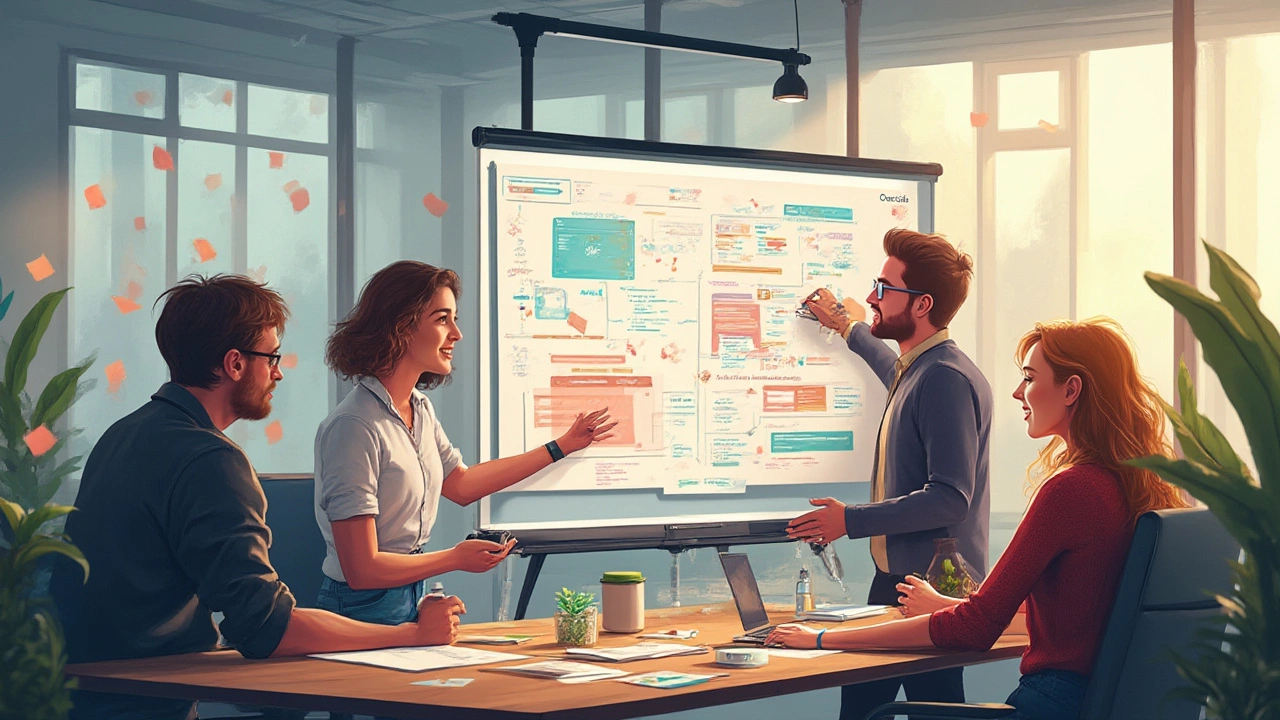Picture this: you’re browsing your favorite site, and it just feels natural. The buttons are right where you expect, colors feel easy on your eyes, and all the info you need seems practically handed to you. Ever wonder how that experience happens? Most people toss around the terms UI, UX, and front-end like they’re interchangeable, but the truth isn’t so tidy. This mix-up has led to some epic job descriptions—and maybe even a few awkward interviews. Let’s clear things up and get into what really separates UI/UX and front-end in the world of web design.
Breaking Down UI, UX, and Front-End: What Do These Mean?
Let’s get the basics sorted before diving any deeper. UI stands for User Interface, the fancy name for what you actually see and touch on an app or website—buttons, icons, colors, fonts, forms, sliders, and so on. Think of it as the visual “skin” of a digital product. UX, or User Experience, is about how it feels—how easy it is to use, whether it solves your problem, and whether you walk away smiling or smashing your laptop. Front-end development, meanwhile, is the tech side of the visual work—imagine someone translating all those pretty UI designs into code that makes websites behave as they should in a real browser.
If you look around job boards, you’ll spot listings for “UI/UX Designer,” “Front-End Developer,” and often, these roles come with a wishlist longer than a Dublin summer. But here’s the kicker—UI/UX is about design and user needs, while front-end development is about bringing those ideas to life with HTML, CSS, JavaScript, and frameworks like React or Vue.
Let’s keep it super simple. UI: what it looks like. UX: how it works for humans. Front-end: code that makes it happen. Yet, they overlap. The best front-end devs have an eye for design, and the top designers know their way around the code. Still, most companies keep these jobs separate for efficiency.
UI/UX Design: The Human Side of Tech
Think of UI/UX as the art of empathy mixed with logic. Designers start with the user’s needs, not code. They research how real people behave, what frustrates them, and where they get stuck. They might study how Irish folks use train ticketing apps or why certain online grocery sites make people abandon their carts. After gathering feedback, UI/UX designers sketch wireframes, plan user journeys, and pick colors and fonts with a purpose—nothing left to chance.
Ever heard of the “three-click rule”? It’s an old belief that users should get anywhere they want on a website within three clicks. While not a strict law, it drives home the idea of making things easy. Designers use real data—like heat maps tracking mouse movements—to tweak and improve user flows. According to the Norman Nielsen Group, businesses that invest in UX see up to a 400% increase in conversion rates. No, that’s not a typo—four hundred percent.
So, UI/UX designers do a whole lot more than just pick pretty colors. They test prototypes, run A/B tests, and ask questions like, “What would happen if we moved this button?” Their tools aren’t text editors or terminals. They work with software like Figma, Sketch, and Adobe XD. Many use sticky notes and piles of coffee cups as their secret weapons.

Front-End Development: The Code that Brings Design to Life
Front-end developers are technical builders. Their job is turning all those detailed UI/UX mockups into a working site or app. If you see a fancy animation, a snappy dropdown, or a flexible layout that works on both your phone and laptop, that’s the front-end team at work. They use HTML for the structure, CSS for the style, and JavaScript for action and flair. Modern front-end work involves frameworks—React, Vue, Angular—making sites faster, snappier, and easier to update.
It’s not just about slapping code together, though. Good front-end devs need a sense of what looks good. If a button gets lost against the background, users get annoyed. If a page loads slower than a pint pours, they’ll bounce. According to HTTP Archive, as of June 2025, the median page weight hit 2.3 MB for desktop, driven by bigger images and more complex scripts. Balancing design, speed, and function isn’t easy—or quick.
Accessibility comes into play too. Adding alt text, keyboard navigation, and screen reader support isn’t always glamorous, but it’s essential. In the EU, websites that don’t meet accessibility standards face legal headaches. Many front-end developers lean on tools like Lighthouse or Axe to check how well their site serves everyone.
This work is detail-heavy. CSS can eat hours, even days, over a layout bug that shows up only in some browser. Front-end devs spend a surprising amount of time talking with designers, asking, “Should this button animate when clicked?” or “What happens when someone’s internet is dodgy?” Communication is the name of the game.
How UI/UX and Front-End Overlap—and Where They Don’t
The lines get blurry between UI/UX and front-end the closer you look. Both care about the final look and feel. But—and this matters—UI/UX isn’t about the code, and front-end isn’t about research or deep-diving into user psychology. Still, some skills do cross over. For example, knowing the limits of CSS or how JavaScript affects performance helps UI/UX designers create practical ideas, not impossible pipe dreams. On the flip side, developers who “get” design can spot clunky visuals or suggest fixes that save time and budget.
Here’s a quick comparison table to show some differences and overlaps:
| Role | Key Focus | Main Tools | Skills Needed | Overlap |
|---|---|---|---|---|
| UI/UX Designer | Look and feel, user journeys, research | Figma, Sketch, Adobe XD | Empathy, creativity, research, design systems | Design handoff, feedback on feasibility |
| Front-End Developer | Building visuals, interactivity, accessibility | HTML, CSS, JavaScript, React, Vue | Code, problem-solving, eye for detail | Implementing designs, suggesting improvements |
The bottom line? The workplace is shifting, and some companies want hybrid “unicorns” who can do both roles, especially in startups. But at scale, the best results come from letting each focus on what they do best. That means designers obsess over people, workflows, colors, and patterns, while developers make sure it all runs buttery-smooth on every device and browser under the sun.
- If you’re curious, there’s a cool stat: as of 2024, Indeed reports UI/UX designers in Ireland earn about €45,000–€60,000, while front-end devs range from €50,000–€80,000, depending on experience. But the hybrid “UI/UX + Code” roles? They can demand even more, if you can pull it off.
- Differentiating your portfolio can help a ton. Designers show off wireframes, user persona docs, and journey maps, while developers lean on live code demos and GitHub repos.
- Some teams use “design systems”—like Google’s Material Design or IBM’s Carbon—which make the handoff from design to development way smoother. These systems include code-ready components and reference files, so everyone stays on the same page.

The Takeaway: UI/UX Is Not Front-End—But Great Web Products Need Both
So, is UI/UX “front-end”? Not exactly. UI/UX is all about what people want and feel when using your site. It’s research, empathy, and creative problem-solving. Front-end is the practical magic, translating those ideas into reality with actual code. There’s overlap in understanding, but the skills and daily work look totally different. Still, you’d be amazed how much chatting, back-and-forth, and compromise it takes to launch a solid website.
If you’re thinking about jumping in—pick the side that excites you. Are you the type who loves tinkering with colors, layouts, and how things feel? Or do you get a buzz from seeing the site work in a real browser, troubleshooting glitches, and writing elegant code? Both paths are in high demand. And if you can learn enough of the “opposite” side to have a conversation with your teammates, you’ll stand out. That’s just how the web world works in 2025 in Dublin—or anywhere these days.
Remember: the best web experiences don’t just look pretty or run fast—they solve real problems for real people. That takes both creative designers and skilled developers working together. So next time you see a site that just feels right, you’ll know who to thank—well, two someones, actually.
